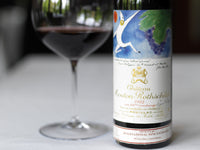
The "Haut Brion" portion of the name appears to, simply, to be a little commercial plagiarisation of the sort that Haut Brion has suffered more than most. Arnaut's grand-daughter left the estate to the Congregation of the Mission in 1654, who built a small chapel in the vineyards called Notre Dame de la Mission. Church ownership seems to have been good for La Mission Haut Brion and the fame of the wines grew. Cardinal Richelieu appears to have been a fan. But Chuch ownership could not survive the French Revolution and the various private owners that followed oversaw a fall in quality and reputation.
The modern history, and revival of La Mission Haut Brion, dates from 1919 when Frédéric Woltner bought the estate. Together with his sons, he revitalised La Mission, installing the, then, cutting edge technology of temperature-controlled fermentation and restructuring the vineyards. The next generation of Woltners, however, fell into discord and sold La Mission Haut Brion to Domaine Clarence Dillon SA, owners of Château Haut Brion in 1983, bringing the two neighbours under the same ownership. Since then, La Mission Haut Brion has grown considerably in reputation and ranks among the best château, not only in Pessac-Léognan, but in Bordeaux as a whole.

The vineyard has a terroir of deep gravel over clay, sand and chalk in the topsoil. Underneath, you find more gravel, which is less refined, along with clay and sand. The vineyard is well placed on a gravel hill that reaches up to 25 meters in elevation at its highest point. With vines averaging 27 years of age, the vineyard is planted to a vine density of 10,000 vines per hectare.
It is interesting to note, that while the chateau is located across the road from Haut Brion, most of the vineyards are not quite as close. While most of the vines used by Haut Brion are in Pessac, the majority of the vines for La Mission Haut Brion are in Talence. Although, there are vines in Pessac Leognan as well.
When you look at the differences in the soils and notice the higher level of vine density at La Mission Haut Brion than at Haut Brion, it is easier to understand the differences in the wines styles.
To produce the red wine of Chateau La Mission Haut Brion, the wine is vinified in large, 180 hectoliter, temperature controlled, stainless steel vats and aged in 100% new, French oak for an average of 22 months. The annual production of La Mission Haut Brion averages between 6,000 and 7,000 cases per year.
Most Common Varietal Blend of Chateau La Mission Haut Brion
- 35% Cabernet Sauvignon
- 58% Merlot
- 7% Cabernet Franc
Food Pairings And Serving
Chateau La Mission Haut Brion is best served at 15.5 degrees Celsius, 60 degrees Fahrenheit. The cool, almost cellar temperature gives the wine more freshness and lift. It is best served with all types of classic meat dishes, veal, pork, beef, lamb, duck, game, roast chicken, roasted, braised and grilled dishes.
Tasting Notes
Spicy and exuberant, La Mission in 2015 is flamboyant and expressive. The palate is layered, joyful and beautifully woven together. An impressive wine that has great concentration and will be one of the vintages that ages well for many decades. 15.5% alcohol.
Big Hammer Wines
The wine experts at Big Hammer Wines taste thousands of wines every year from around the globe, looking for quality and value. This special offer reflects the passion we have for our clients.
Discover the world through its wines, ClickHere! Visit Bighammerwines.com and become a wine expert!
Leave a comment (all fields required)
Comments will be approved before showing up.


